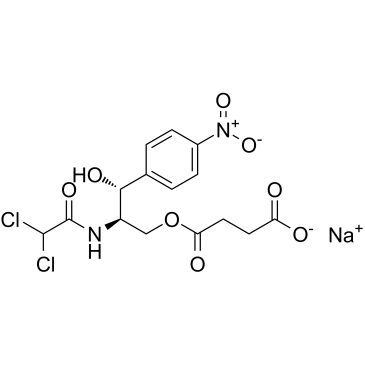Chloramphenicol sodium succinate

Chloramphenicol sodium succinate structure
|
Common Name | Chloramphenicol sodium succinate | ||
|---|---|---|---|---|
| CAS Number | 982-57-0 | Molecular Weight | 445.184 | |
| Density | N/A | Boiling Point | 716.3ºC at 760mmHg | |
| Molecular Formula | C15H15Cl2N2NaO8 | Melting Point | N/A | |
| MSDS | Chinese USA | Flash Point | 387ºC | |
| Symbol |

GHS08 |
Signal Word | Warning | |
Use of Chloramphenicol sodium succinateChloramphenicol succinate sodium is a prodrug of Chloramphenicol, with Haemotoxicity. Chloramphenicol succinate is a competitive substrate and inhibitor of succinate dehydrogenase (SDH) that is the possible reason for its toxicity[1][2][3]. |
| Name | Chloramphenicol sodium succinate |
|---|---|
| Synonym | More Synonyms |
| Description | Chloramphenicol succinate sodium is a prodrug of Chloramphenicol, with Haemotoxicity. Chloramphenicol succinate is a competitive substrate and inhibitor of succinate dehydrogenase (SDH) that is the possible reason for its toxicity[1][2][3]. |
|---|---|
| Related Catalog | |
| References |
| Boiling Point | 716.3ºC at 760mmHg |
|---|---|
| Molecular Formula | C15H15Cl2N2NaO8 |
| Molecular Weight | 445.184 |
| Flash Point | 387ºC |
| Exact Mass | 444.010315 |
| PSA | 161.58000 |
| LogP | 0.90410 |
| InChIKey | RPLOPBHEZLFENN-HTMVYDOJSA-M |
| SMILES | O=C([O-])CCC(=O)OCC(NC(=O)C(Cl)Cl)C(O)c1ccc([N+](=O)[O-])cc1.[Na+] |
CHEMICAL IDENTIFICATION
HEALTH HAZARD DATAACUTE TOXICITY DATA
MUTATION DATA
|
| Symbol |

GHS08 |
|---|---|
| Signal Word | Warning |
| Hazard Statements | H351 |
| Precautionary Statements | P280 |
| Personal Protective Equipment | Eyeshields;full-face particle respirator type N100 (US);Gloves;respirator cartridge type N100 (US);type P1 (EN143) respirator filter;type P3 (EN 143) respirator cartridges |
| Hazard Codes | Xn: Harmful; |
| Risk Phrases | R40 |
| Safety Phrases | 22-36 |
| RIDADR | NONH for all modes of transport |
| WGK Germany | 3 |
| RTECS | AB6905000 |
|
The myelotoxicity of chloramphenicol: in vitro and in vivo studies: II: In vivo myelotoxicity in the B6C3F1 mouse.
Hum. Exp. Toxicol. 17(1) , 8-17, (1998) 1. Chloramphenicol continues to be widely used in many parts of the world despite its known haematotoxicity. Until now, elucidation of the mechanisms involved and any attempt at amelioration of the to... |
|
|
A commercial enzyme immunoassay method (EMIT) compared with liquid chromatography and bioassay methods for measurement of chloramphenicol.
Clin. Chem. 34(9) , 1872-5, (1988) A new enzyme immunoassay method (EMIT; Syva Co.) was compared with conventional high-performance liquid chromatography (HPLC) and agar-diffusion bioassay methods for measurement of chloramphenicol in ... |
|
|
Chloramphenicol succinate, a competitive substrate and inhibitor of succinate dehydrogenase: possible reason for its toxicity.
Toxicol. In Vitro 18(4) , 441-7, (2004) From our previous study [Eur. J. Clin. Pharmacol. 56 (2000) 405] we hypothesized that chloramphenicol succinate (CAPS) may be a competitive substrate for succinate dehydrogenase (SDH). It may be oxidi... |
| (R-(R*,R*))(-)-Butanedioic Acid Mono(2-((2,2-dichloroacetyl)amino)-3-hydroxy-3-(4-nitrophenyl)propyl) Ester Monosodium Salt |
| Globenicol |
| Chloramphenicol succinate sodium |
| Nevimycin |
| Clorofenicina |
| Solnicol |
| 2,2-Dichloro-N-(b-hydroxy-a-(hydroxymethyl)-p-nitrophenethyl)acetamide a-Ester with Sodium Succinate |
| Chloramphenicol monosuccinate sodium salt |
| protophenicol |
| Betamicetin |
| Nalecin |
| EINECS 213-568-1 |
| MFCD00083598 |
| Levomycetin-Nalcein |
| D-threo-(-)-2,2-Dichloro-N-(b-hydroxy-a-(hydroxymethyl)-p-nitrophenethyl)acetamide a-(Sodium Succinate) |
| Cloromoin |
| butanedioic acid, mono[(2R,3R)-2-[(dichloroacetyl)amino]-3-hydroxy-3-(4-nitrophenyl)propyl] ester, monosodium salt |
| CHLORAMPHENICOL,NASUCCINATE |
| Butanedioic acid, mono[(2R,3R)-2-[(2,2-dichloroacetyl)amino]-3-hydroxy-3-(4-nitrophenyl)propyl] ester, sodium salt (1:1) |
| Chloramphenicol sodium succinate |
| Sodium 4-{[(2R,3R)-2-[(dichloroacetyl)amino]-3-hydroxy-3-(4-nitrophenyl)propyl]oxy}-4-oxobutanoate |
| Mychel-S |
| Sodium chloramphenicol succinate |